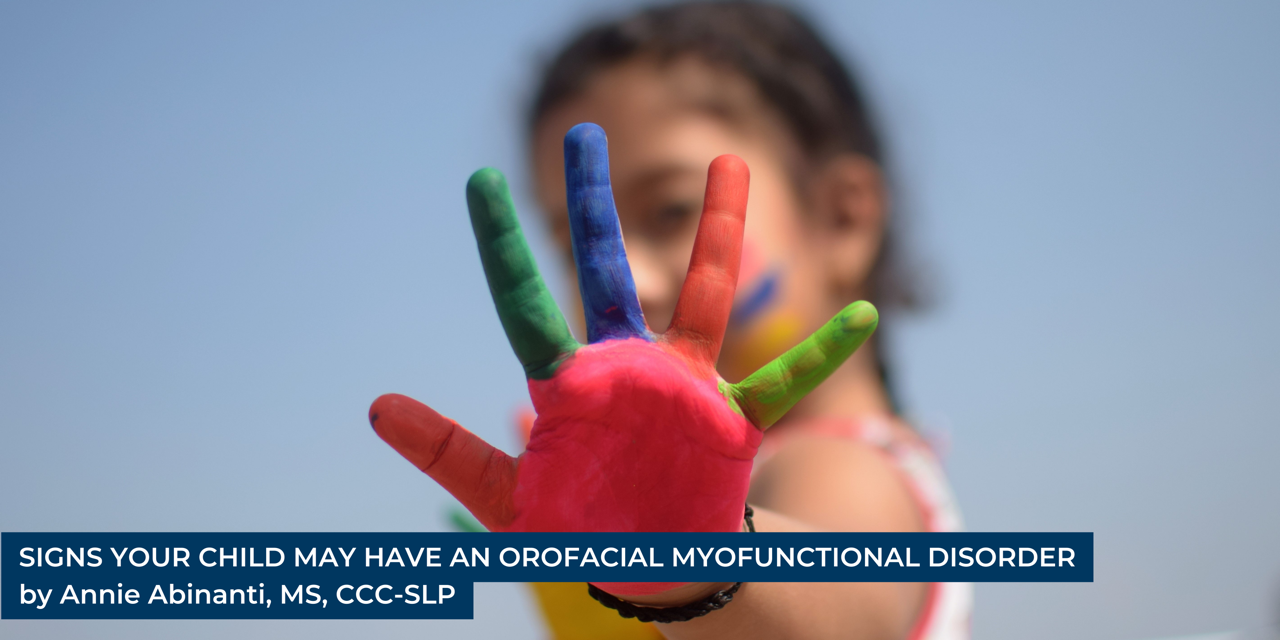
As a parent, you may be wondering what is an orofacial myofunctional disorder and how do I know if my child has one? Let’s first define it. Orofacial myofunctional abilities refers to the study of muscles of the oral and facial complex in relation to swallowing function, dentition, articulation, facial development and overall health. Myofunctional abnormalities include improper lip and tongue resting position, lack of nasal breathing, bruxism (grinding teeth), tongue protrusion during swallowing or speaking, poor mastication (chewing) and bolus collection, lip incompetency (due to either a structural abnormality or tethered oral tissue), and thumb/digit sucking.
Myofunctional disorders can be caused by any of the following (which is not exhaustive):
- Allergies – Seasonal, environmental or food sensitivities/allergies can cause nasal inflammation, forcing mouth breathing.
- Chronic sinus congestion – Causes inflammation in the nasal cavity, lending to mouth breathing
- Mouth breathing – tongue rests on the bottom of the mouth, resulting in weak tongue, cheek and lip muscles. Orofacial structures are then affected (high and narrow palate, changes to the dental contour, reduced tone, facial/skeletal changes).
- Extended use of a pacifier (beyond 18-24 months) or sippy cups – Encourages a front to back tongue pumping swallowing pattern rather than a more mature, forward-upward swallowing pattern. This can result in development of a high palate, open bite (when front teeth do not come together), dental arch is displaced forward and up, and tongue resting position is down at the bottom of the mouth, causing open mouth breathing and the musculature issues (explained above in mouth breathing).
- Tethered oral tissues (lip or tongue ties) – Tongue ties keep the tongue pulled down/tethered toward the jaw, causing tongue immobility, weakness, limited range of motion, compensations and tension from other orofacial structures (lips, jaw, neck, etc.), a forward head posture, and anteriorly rolled shoulders. Tethered oral tissues can change the skeletal look of the face, pulling from other tissue to compensate for lack of movement, altering dental bites, smaller jaws and misaligned teeth. Lip ties can cause tooth decay, diastema (separation between the two front incisor teeth) which will persist even after orthodontia work if they remain too tight and are not released.
- Enlarged adenoids and tonsils – Reduces the overall space for breathing, contributing to sleeping issues (including sleep disordered breathing). It displaces the tongue forward due to limited room toward the back of the mouth, resulting in tongue thrusting and incorrect tongue resting position for optimal breathing.
Knowing all that, if your answer is yes to any of the following, it would be highly beneficial to have your child evaluated for an orofacial myofunctional disorder:
- Is your child constantly congested or become frequently sick, especially recurring strep throat or respiratory infections?
- Does your child breathe with an open mouth either during the day or while sleeping?
- Does your child appear tired, constantly exhausted, have circles under their eyes, or have difficulty sleeping?
- Does your child snore, become restless or wake up in bizarre positions?
- Has your child used a pacifier or sucked on his/her fingers for longer than 2 years of age?
- Does your child have significant allergies, get frequently sick or have difficulty breathing?
- Did your child ever struggle with breastfeeding?
- Did your child ever have a tongue tie?
- Does your child have an open bite (space between teeth when teeth are closed)?
- Has your child been in traditional speech therapy with limited progress?
- Has your child had multiple cavities or had more than one pair of braces?
- Is your child a loud, messy breather?
Feel free to contact us with any questions or concerns. We would love to help ease your concerns!